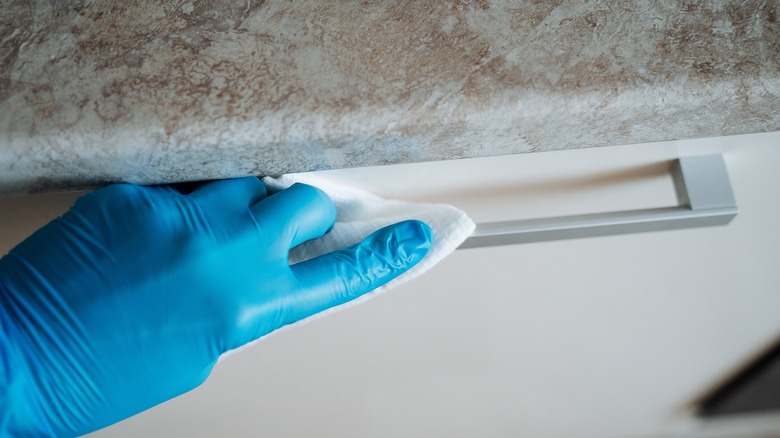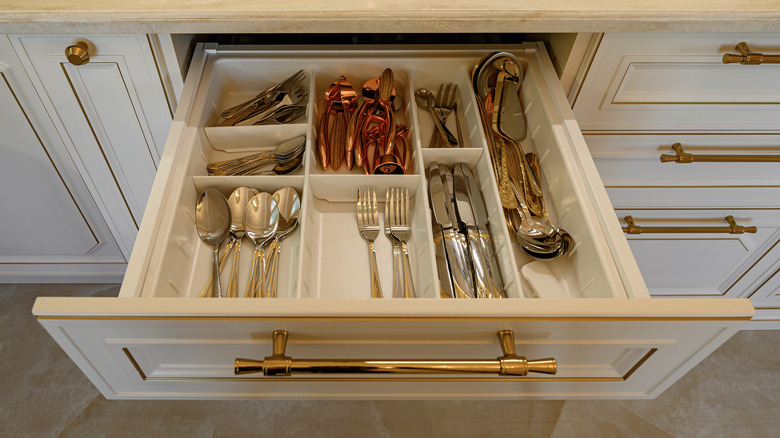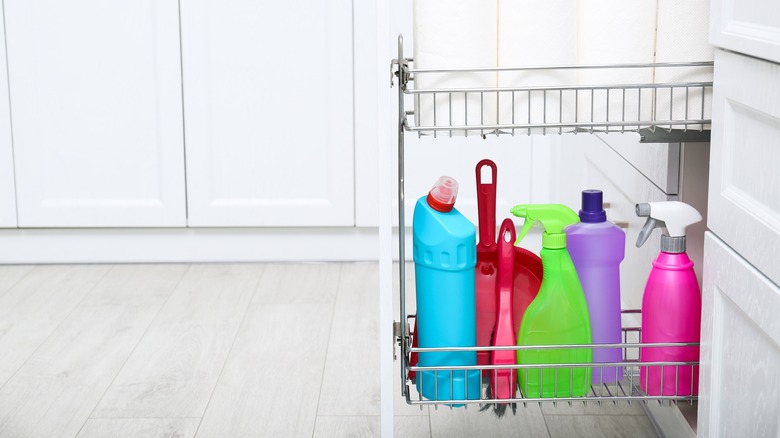The Best Way To Clean The Drawer Pulls In Your Kitchen
If you're a confident cook and someone challenged you to cook a full dinner in 20 minutes, in your own kitchen, minus one important piece of equipment, you would probably say, "No big deal!" But what if they took all of the hardware from your drawers and cabinets? When you think about it, drawer pulls are the unsung heroes of the kitchen, in nearly constant use. It would be a nightmare to lose them and yet, how often do we think about their upkeep?
It's not a big leap to imagine that, left untended, they're a potential breeding ground for germs, as is confirmed by Hardware Hut. Drawer pulls can easily get overlooked between everyday cleaning maintenance and big, rare household jobs like gutter cleaning or mattress-flipping. According to Moshells, you ought to clean your light switches every two weeks. We're here to suggest that your kitchen drawer pulls receive at least that amount of attention, given the higher overall risk of contamination during food preparation.
Cleaning the drawer pulls in your kitchen can give them a new lease on life, making them seem almost like new fixtures, says Farmer's Almanac. So, what are you waiting for? Let's get to it!
Best way to clean drawer pulls in your kitchen
The simplest and quickest way to clean your drawer pulls is to wipe them with a clean, damp cloth on a daily basis. This is the best way to prevent build-up of the grime that eventually leads to deeper discoloration and tarnishing, not to mention germs and potential infections. Most people don't wipe the handles of their kitchen down every day, and even a few weeks is enough time for grease to build up on a handle that's in use all of the time, especially those closest to the sink or stove.
When gunk has built up on drawer pulls over a more extended period of time, it becomes harder to remove. Per Life Maid Easy, it's worth breaking out the screwdriver and removing the fixtures from the drawers in order to soak and scrub them so they end up thoroughly spotless.
More often than not, a greasy handle can be cleaned with warm, soapy water and a soft rag. You could also make your own homemade cleaner like this one with eucalyptus essential oil. For the tougher jobs, you'll want to consider that different cleaning products work best for different materials and finishes.
Cleaners for the tougher jobs
The material from which the drawer pulls are made will have an impact on which cleaning products you should use on them. Many solutions include an acid, such as vinegar, which can be a versatile cleaning tool. It's so effective that soaking handles in a 50/50 solution of warm water and vinegar can lift the grease and grime without so much as a wipe, advises Simply Beautiful Kitchens.
Some, like Farmer's Almanac, claim lemon and salt are known to scour away tarnish. However others, like Tips Bulletin, say rubbing brass with cider vinegar and salt is actually a way to deliberately age and tarnish fixtures! Instead, consider using a store-bought brass hardware cleaner, which will be formulated to avoid tarnishing fixtures and help them keep their brightness for longer.
Per Livspace, wooden handles can be soaked in a soapy solution or a mix of water and vinegar. Remember not to let them soak for too long though because the wood can absorb water and swell. Stainless steel fittings will be easily damaged by abrasives, chlorides, or bleach. If marks are persistent, mixing equal parts olive oil and vinegar can be effective, according to Spark & Burnish. For ceramic drawer pulls, Kitchen Infinity suggests using toothpicks that have been soaked in baking soda. A diluted solution of warm water and bleach will also work if needed. Brushing with vegetable oil can help protect ceramic handles from discoloration.


